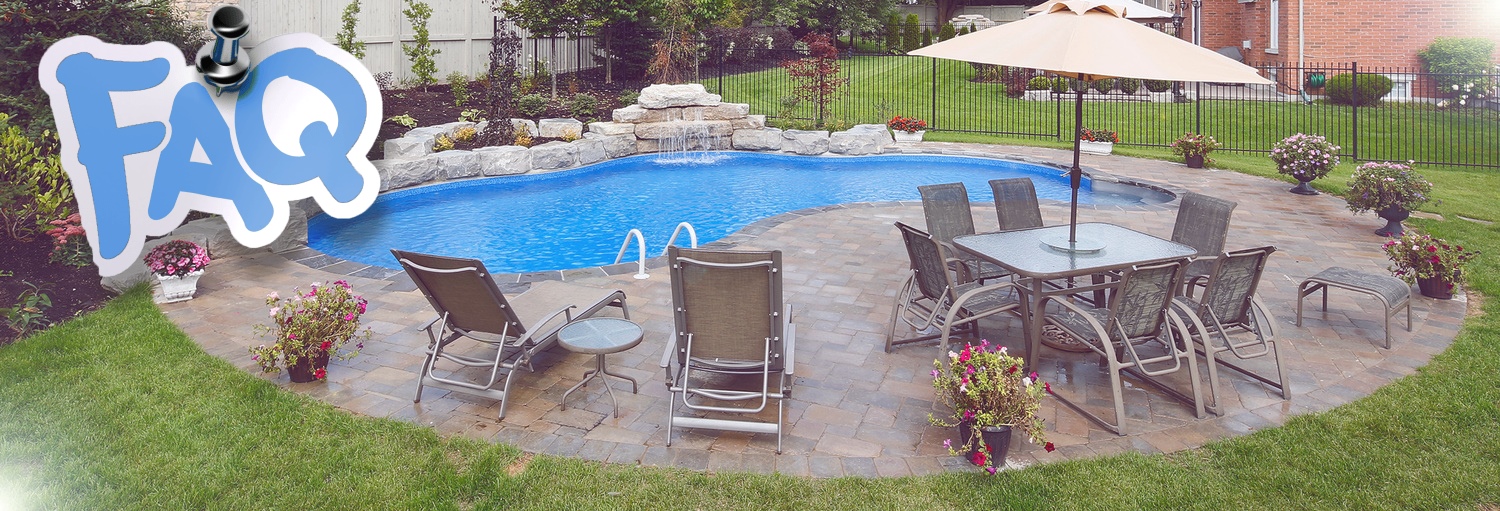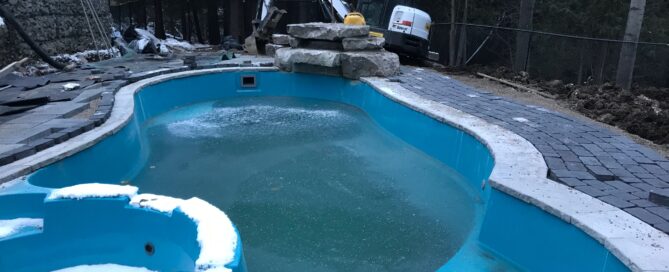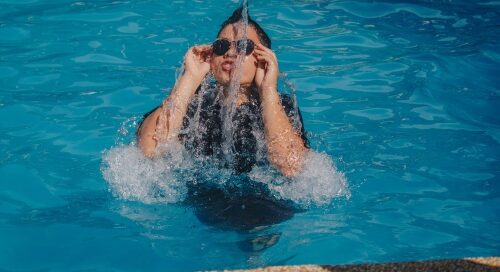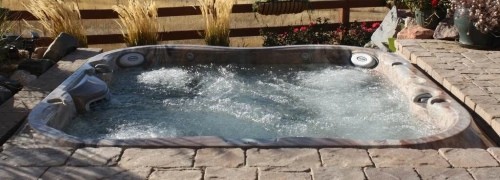
Advantages of Fiberglass:
- Fiberglass swimming pools have the lowest cost of ownership over time. The fiberglass shell resists algae growth, the shell is a better insulator, and the structure never needs liner replacements or resurfacing like vinyl liner and gunite/concrete pools.
- Fiberglass swimming pools have great molded steps, benches, coves, and sun deck configurations. Just like today’s hot tubs the molds that create the swimming pool designs are very luxurious. No other construction method has better design options.
- Fiberglass swimming pools are the quickest to construct and weather does not affect the construction process as much as vinyl or gunite. The fiberglass pool can be constructed in about two weeks from concept to completion.
- Virtually any type of impact damage can be repaired Just as a boat or yacht can be repaired. Fiberglass swimming pools can be easily repaired on site. The only way damage could occur is from a significant impact or improper installation. These pools are tough and flexible!
- Fiberglass swimming pools resist the growth of algae far better than vinyl liner pools because the surface is less porous and does not harbor algae as easily. This also contributes to easier vacuuming, and water line cleaning.
- Fiberglass pools are a greener choice, the emitted ions created during construction are regulated and the consistent replacement of the vinyl liner creates considerable vinyl waste. With lower operating costs and a longer life span the fiberglass pool is a greener choice.
- No potential for corrosion, the fiberglass swimming pool is the best choice for today’s salt purification systems making pool ownership a breeze. Just think about how many vessels are made of fiberglass and remain in salt water for many years.
- Fiberglass pools have the best feel on your feet when you are in the water. The shells feel very solid and the surface is not abrasive like gunite/concrete.
- Non slip steps and floors are a nice addition in the fiberglass swimming pool, the manufacture can easily add non slip texturing to the swimming pool steps and floor. This makes the entry steps very safe and gives the user confidence while entering or exiting the pool.
- Scratches can be easily sanded and buffed if the shell becomes damaged; just like a quality yacht the fiberglass gel coat surface is thick and can allow for buffing and sanding if necessary.
One of the best pool area remodeling projects is the addition of a hot tub. Hydrotherapy, or warm water therapy in hot tub, consists of three main healing ingredients; heat, buoyancy, and massage. Together, they create an experience that is both relaxing and healthy. Hot tub hydrotherapy on a regular basis provides physical health benefits that go much deeper than just relaxation and pleasure.
Water is so pure and simple, yet it can do the most amazing things. Whether you are experiencing joint or muscle pain, having trouble sleeping, or are just plain stressed out, spending time in hot tub can provide therapeutic benefits for just about everyone.
Another way to promote your health and fitness by remodeling a pool area is to add resistance jets to a lap pool. This provides an “endless” current that a swimmer can swim against. Swimming is an activity that can be done at any age and provides an excellent workout of all muscle groups.
It is a good idea to completely drain and refill your hot tub every 8 weeks. If you do not use the hot tub as often, you can generally go 12 weeks between water changes. Making sure that your hot tub has fresh water will also guard against the possibility of the heater coil corroding prematurely.
Yes. Although most of the time ants are harmless, they have the ability to move large amounts of sand, and can cause pavers to sink. If you decide to use a commercial ant killer, first test it on a small area to make sure it doesn’t discolor the pavers.
Patterned concrete pavements are merely slabs of concrete that are embossed with a pattern. Therefore, they are prone to the same problems with freeze/thaw cycles, namely cracking and spalling. Pavers won’t crack or spall. Stamped concrete requires expansion joints every 10 feet or so, which are very distracting in some patterns. Also, unlike pavers, patterned concrete pavements don’t allow access to underground utilities or the ability to make repairs. At virtually the same price per square foot installed, pavers are clearly a superior choice.
The benefits of sealing your pool pavers cannot be underestimated. Sealing them will intensify the colors and help you manage the everyday stains that may occur. This will ensure you can enjoy your pool for years without the need for constant repair and maintenance.
- Cover frequently traveled areas of the pool deck with no-slip mats to prevent wear and tear.
- Keep metal furniture off of the pool deck. Rust stains from metal chairs can stain your pool deck.
- Clean your pool deck frequently with a leaf blower or hose.
- Clean up spills as soon as they drop to prevent staining.
- Keep your deck area clear of overhanging trees. Leaves and fruit that drop on the deck can stain it.
- Likewise, avoid spilling fertilizer on your pool deck. Fertilizer contains iron, which can leave a hard-to-remove orange stain.
The benefits of sealing your pool pavers cannot be underestimated. Sealing them will intensify the colors and help you manage the everyday stains that may occur. This will ensure you can enjoy your pool for years without the need for constant repair and maintenance.
Your building department may require a site plan to be submitted with your application for permit along with the swimming pool plans. It must show all property lines, any structures and the proposed swimming pool or spa. It has to be to scale and dimensioned. It also has to show other details such as your fence, gates, electric and gas meter location.
A saline (saltwater) sanitization system provides on-site production of the sanitizer necessary to maintain water in a safe, healthy and algae-free condition. Sanitizer is produced automatically, within the water itself, and involves no handling, storage or adding of chemicals to the water. A saltwater system, properly sized for its application, will eliminate the need to purchase sanitizing chemicals such as – pool chlorine, algaecides and shock chemicals.
When you call for your quote, you need to answer the following questions:
- What is the approximate size of the pool (gallons or dimensions)?
- Do you need additional landscaping
- Do you want a hot tub and/or fountains in your pool?
Your phone quote will usually be a range of price, from lowest to highest.
Regarding the pool shell and finish itself, then the darker the finish the better. Black has been a recent favorite of pool owners for a surface color. A black finish gives the swimming pool a “lagoon” look, however there are people who do not like that look. A disadvantage to the black is that if you are not diligent with pool chemistry, you can end up with black algae because it is hard to see in a black finished pool. Another is that, again, if you are not right on with chemicals you can end up with a nearly white pool within a few years due to calcium buildup.Regarding the pool shell and finish itself, then the darker the finish the better. Black has been a recent favorite of pool owners for a surface color. A black finish gives the swimming pool a “lagoon” look, however there are people who do not like that look. A disadvantage to the black is that if you are not diligent with pool chemistry, you can end up with black algae because it is hard to see in a black finished pool. Another is that, again, if you are not right on with chemicals you can end up with a nearly white pool within a few years due to calcium buildup.
Routine shock treatment is necessary to destroy water contaminates that reduce the efficiency of the disinfectant or sanitizer. Contaminates like hair spray, suntan oil, cosmetics and other organic materials react with chlorine and cause eye or skin irritations and an unpleasant chlorine odor. Most often pools are inaccurately accused of having too much chlorine when this problem is present.
In order to prevent scaling or corrosive action and to achieve maximum swimmer comfort, pool water should be balanced to the following levels:
| Test | Range |
|---|---|
| pH | 7.2-7.6 |
| Total Alkalinity | 120-150 ppm |
| Calcium Hardness | 200-250 ppm (Gunite) |
| Calcium Hardness | 175-225 ppm (Vinyl) |
| Free Chlorine | 1-3 ppm |
| Free Bromine | 3-5 ppm |
| Copper | 0 ppm |
| Iron | 0 ppm |
You should check the expiration date on your pool chemicals and discard and replace any that have expired. Never dispose of chemicals in the household trash or down any drains unless directed by a water treatment facility. Never pour chemicals down a drain or toilet if they lead to a septic tank. Always make it part of your spring pool opening plan to buy new chemicals from your local professional pool retailer.
Generally it is safe to use your pool after chemicals have dispersed throughout the pool, usually 15 minutes to one hour. If shocking your pool, wait until the chlorine levels drops to recommended levels.
Chlorine in swimming pools kills the germs that may make people sick, but it takes time. Chlorine in properly disinfected pools kills most germs that cause RWIs within minutes. However, it takes longer to kill some germs such as Cryptosporidium that can survive for days in even a properly disinfected pool.
Also, many things can reduce chlorine levels in pool water. Some examples are sunlight, dirt, debris, and material from swimmer’s bodies. Healthy swimming behaviors and good hygiene are needed to protect you and your family from RWIs and will help stop germs from getting in the pool.




